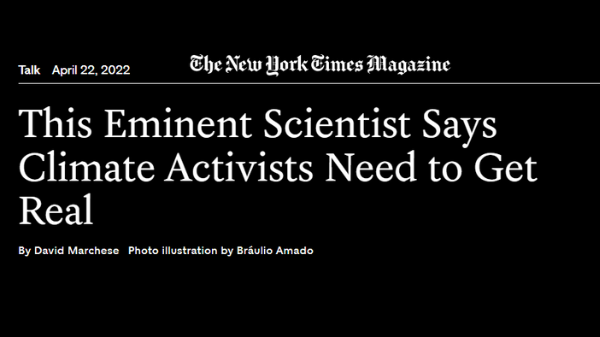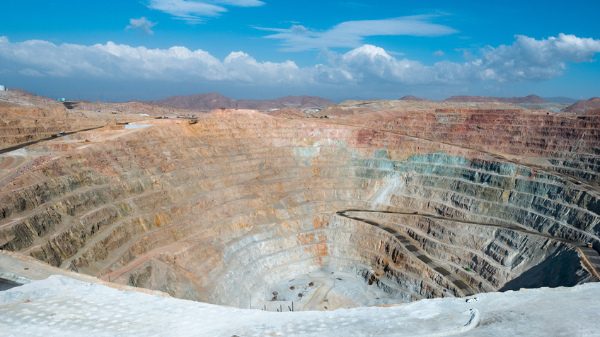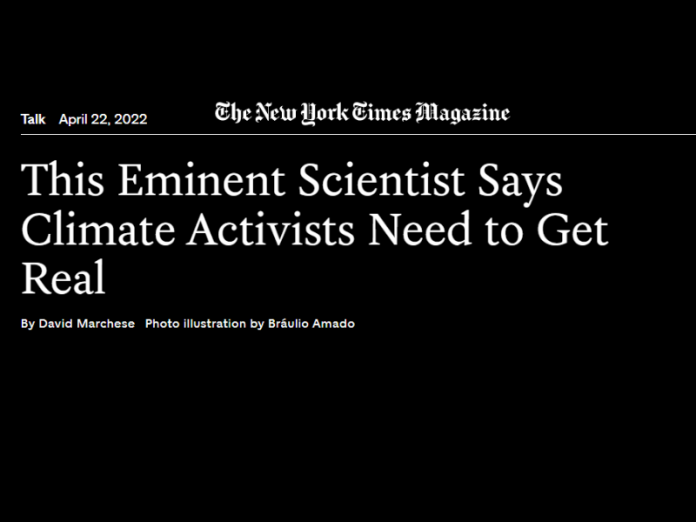YOU SHOULD SUBSCRIBE TO CLIMATE CHANGE WEEKLY.
IN THIS ISSUE:
- Climate Realism on the Rise?
- Podcast of the Week: Rolling Blackouts Are Coming
- Decarbonization Requires Huge Amount of Materials
- Video of the Week: Biden’s ‘Clown Show’ Energy Policy Causing Economic Pain
- BONUS Video of the Week: Breaking Down the Biden Energy Narrative
- Climate Comedy
- Recommended Sites
Climate Realism on the Rise?

As a climate and energy realist, in my heart of hearts I dream of the day when the public recognizes climate change will not bring on an end of the world as we know it, or even a long-term net decline for human civilization. That’s what the data and the best science show, despite the claims of corporate media, alarmist activists, heads of corporations, and politicians who profit in terms of money and power by spinning the climate change end-of-the-world fairy tale. Sadly, the public rarely gets to hear this truth.
A few notable instances of the very unalarming facts about climate change getting through on a large scale in the past few years are the release of several bestselling books by prominent liberals advocating what they consider to be reasonable climate policies: Michael Shellenberger’s Apocalypse Never, Steven Koonin’s Unsettled, and Bjorn Lomborg’s False Alarm. Sticking strictly to climate science, not policy, Heartland’s own Climate at a Glance for Teachers and Students has also sold well on Amazon. However, despite the success of these publications among the literati and reading public, I’d be surprised if these books combined sold more than a million copies in the United States, which has a population of more than 330 million people, or a few million copies among the eight billion people worldwide. Sadly, I suspect more people are exposed to false climate alarm stories in the mainstream media every day in the United States than have been reached by all these books in the past two years since the first one’s release.
Still, hope springs eternal and climate realists keep on plugging away, trying to breach the nearly impregnable wall of climate change disinformation erected by powerful corporate, media, and political elites. Every so often, the realists score a direct hit, making the climate/energy realist case so powerfully that even the mainstream media and elite journals take notice. This occurred recently when The New York Times Magazine (NYTM) published an interview with eminent scientist Vaclav Smil, Ph.D., discussing his book How the World Really Works: The Science Behind How We Got Here and Where We’re Going.” (You can’t get more mainstream and yet elitist than the NYTM.) Another direct realist hit on the edifice of climate alarm came with the publication of the article “Russia’s War Is the End of Climate Policy as We Know It,” in the journal Foreign Affairs, by Ted Nordhaus.
Both Smil and Nordhaus have far more confidence than I that human activities are causing potentially dangerous climate change. Although I disagree to some extent with their assessment of the dangers of climate change, their “realpolitik” analyses of the infeasibility of the net zero energy transition in the 2030-2050 timeline are powerful and accurate.
Despite continual cajoling by the NYTM interviewer, who basically framed the same question again and again and again, pleading for Smil to concede climate change is such an imminent disaster world leaders must forcibly decarbonize our energy systems nearly immediately, Smil refused to rise to the bait. His consistent answer, based on his assessment of the world’s energy needs and the material requirements necessary to meet net zero in the short term, was that this goal is physically and politically impossible. Smil also made clear that the threat posed by climate change does not justify such a dramatic forced transition.
For Smil, the four pillars of modern civilization are cement, steel, plastics, and ammonia, each of which requires huge amounts of fossil fuels to produce. Therefore, he concludes, those calling for rapid decarbonization to combat global warming are being dangerously foolish. “I’m looking at the world as it is,” Smil, told the NTYM interviewer, continuing,
The most important thing to understand is the scale. … [A]ccording to COP26, we should reduce our carbon dioxide emissions by 45 percent by 2030 as compared with 2010 levels. This is undoable because there’s just eight years left, and emissions are still rising. People don’t appreciate the magnitude of the task and are setting up artificial deadlines which are unrealistic. …
What’s the point of setting goals which cannot be achieved? People call it aspirational. I call it delusional.
I’m all for goals but for strict realism in setting them.
For Smil, radical actions to cut carbon dioxide emissions steeply and immediately are neither justified by the problem—because other problems are at least as dire as climate change, and they require fossil fuels to solve—nor are they possible, even if they were justified. It’s a matter of both physics and realpolitik, the latter meaning an honest assessment of the fact that people around the world do and will continue to want to better their lives by their own understanding of what constitutes a better life.
Smil’s assessment coincides with that of Ted Nordhaus, the cofounder (with the above-mentioned Michael Shellenberger) and executive director of the Breakthrough Institute and a coauthor of An Ecomodernist Manifesto. Nordhaus’s article in Foreign Policy is a realist shot across the bow explaining how Russia’s invasion of Ukraine is opening eyes to the basic energy truth that fossil fuels are still vital to the world:
[T]he headlong rush across Western Europe to replace Russian oil, gas, and coal with alternative sources of these fuels has made a mockery of the net-zero emissions pledges made by the major European economies just three months before the invasion at the U.N. climate summit in Glasgow, Scotland. Instead, questions of energy security have returned with a vengeance as countries already struggling with energy shortages and price spikes now face a fossil fuel superpower gone rogue in Eastern Europe.
In the decades following the end of the Cold War, global stability and easy access to energy led many of us to forget the degree to which abundant energy is existential for modern societies. Growing concern about climate change and the push for renewable fuels also led many to underestimate just how dependent societies still are on fossil fuels. But access to oil, gas, and coal still determines the fate of nations. Two decades of worrying about carbon-fueled catastrophes—and trillions of dollars spent globally on transitioning to renewable power—haven’t changed that basic existential fact. …
Given the scant effect international climate efforts have had on emissions over the past three decades, a turn back toward energy realpolitik—and away from the utopian schemes that have come to define climate advocacy and policymaking worldwide—could actually accelerate the shift to a lower-carbon global economy in the coming decades. …
The capacity to adapt to rising temperatures and extreme weather events rose significantly … as evidenced by the continued decline in weather-related deaths. But this was not due to any U.N.-led efforts to fund climate adaptation, which never materialized. What made people all over the world more resilient to climate extremes was better infrastructure and safer housing—the product of economic growth powered by cheap fossil fuels.
The geopolitical, technological, and economic competition that characterized the Cold War had more success in reducing the carbon intensity of the global economy than climate policy efforts have had since.
Nordhaus goes on to explain:
The world’s renewable energy economy is deeply entangled with geopolitically problematic supply chains. Huge parts of the world’s supplies of silicon, lithium, and rare-earth minerals rely on China, where solar panels are produced by Uyghur slave labor in concentration camps. The idea that the crisis might be resolved by choosing Western dependence on Chinese solar panels and batteries over Western dependence on Russian oil and gas reveals just how unserious the environmental movement’s pretensions to justice, human rights, and democracy really are.
For Nordhaus and Smil alike, the appropriate response to climate change is to acknowledge the reality of the importance of fossil fuels to continued economic prosperity for the present, while delivering better options through the market—which responds to price signals through efficiency gains and technological innovation—far faster and more effectively than government-mandated energy shifts. Smil states,
at the same time we are constantly transitioning and innovating. We went from coal to oil to natural gas, and then as we were moving into natural gas we moved into nuclear electricity, and we started building lots of large hydro, and they do not emit any carbon dioxide directly. So we’ve been transitioning to lower-carbon sources or noncarbon sources for decades. Moreover, we’ve been making our burning of carbon much more efficient. We are constantly transitioning to more efficient, more effective and less environmentally harmful things.
Nordhaus notes the Russian war is increasingly making it clear to countries that climate change is not “the main event,” energy security is, and the latter can be achieved while improving economic conditions in the poorest countries and respecting human rights:
But climate and energy policies, especially in the West, may shift significantly from subsidizing demand (for things like solar panels and electric vehicles) to deregulating supply (of things like nuclear power plants and high-voltage transmission lines). A shift of this sort—away from subsidizing specific green technologies favored by activists and lobbyists and toward enabling the broader technological, regulatory, and infrastructural basis for the energy transition—would put clean energy policies on much firmer economic footing. And it would better align climate objectives with energy security imperatives.
People around the world face many problems. Climate change is only one among many, and as Nordhaus and Smil point out, it is probably not the most pressing.
Nordhaus and Smil provide clear-eyed assessments of the physical, economic, and political limits of the energy transition demanded by climate alarmists on the timetable they have laid out. These analysts’ acknowledgements of the benefits fossil fuels have delivered, and the inequities and harms that would result from an attempt to go net zero by 2030 or even 2050, are a refreshing appraisal from scholars whom alarmists cannot in any way smear as “climate deniers.”
In my heart of hearts (foolish though it may be), I still hold out hope this truth can get through the daily background noise of climate alarm.
SOURCES: Foreign Policy; New York Times Magazine; Cornwall Alliance; Washington Times
Friday, June 17 at Noon CT | Join the show LIVE on YouTube
Podcast of the Week
The Heartland Institute’s H. Sterling Burnett joined the Tony Katz show to discuss how Senator Debbie Stabenow (D-MI) bragged about driving her expensive electric vehicle across the country. Meanwhile, liberal policies from her party are bankrupting regular Americans. Burnett and Katz also discuss a new Reuters’ article about how Midwesterners will deal with rolling blackouts this summer. It’s as if we’re moving backwards in terms of energy policy.
Subscribe to the Environment & Climate News podcast on Apple Podcasts, iHeart, Spotify or wherever you get your podcasts. And be sure to leave a positive review!
Get your Copy at Amazon TODAY!
Decarbonization Requires Huge Amount of Materials

New research published at Research Square estimates the huge increase in materials necessary to hit either the soft or hard temperature targets, 1.5℃ and 2℃ respectively, designated in the Paris climate agreement. In addition to being expensive, producing the materials will add large amounts of carbon dioxide to the atmosphere because it requires fossil-fuel-intensive activities such as mining, refining, and transportation.
The authors find the demand for materials for the electric power sector will greatly increase the amount of battery, solar, and wind power on the grid in order to decarbonize it along the timelines in the Paris climate agreement commitments from 2020 through 2050. There is enough of these resources available, but the enormous quantities needed will require a massive increase in production.
“We find that demand increases but cumulatively does not exceed current geological reserves,” says the report. “However, annual production of materials including neodymium (Nd), dysprosium (Dy), tellurium (Te), fiberglass, and solar-grade polysilicon may need to grow considerably … [with] power sector decarbonization [requiring the] mobiliz[tion of] large quantities of materials, likely necessitating continued development of existing and new mineral resources.”
The additional demand for materials will require huge increases in production:
For many of the studied materials, demand from clean power generation infrastructure will comprise a considerable proportion of total global production. At the peak pace of a 1.5°C consistent scenario, for instance, silver demand for solar panels might require ~10% of current world production. Future aluminum and copper demand for power sector infrastructure could require ~18% of current production. CuInGaSe (CIGS) thin-film solar could strain supply chains for indium and selenium even if CIGS thin-film is installed at a relatively low percentage of overall future solar PV capacity (2%) consistent with today’s market share. Yearly demand for solar-grade glass and for fiberglass composites used in wind turbine blades could require a fifth to a quarter or more of current annual global flat glass manufacturing and the entirety of glass fibre production [emphasis mine].
For some materials (dysprosium, neodymium, solar-grade polysilicon, tellurium), the peak annual power sector demand over coming decades will considerably exceed current global production rates, requiring large increases in production. Rare earths for wind turbines alone might require tripling global rare earth metal production, while buildout of CdTe thin-film solar could necessitate an even larger increase in global tellurium production. Estimated future solar-grade polysilicon demand will also outstrip current production, potentially by more than a factor of two.
In addition, meeting this demand will force a shift in production, manufacturing, and consumption priorities that will transfer inordinate geopolitical power to countries that dominate the production and refining of these materials, such as China, the report notes.
“Because extraction and/or processing of some critical materials remains highly concentrated in just one or a handful of countries, they have outsized economic and geopolitical importance,” the report states. “Mineral supply chains have been used as political and economic leverage during international disputes in the recent past.”
Nor is the outlook good from an environmental or climate perspective. “Mining, processing, and refining of raw ores is often energy- and emissions-intensive,” the report states. “Mining activities can impact the health of laborers and nearby populations and also destroy or degrade ecosystems.” Meanwhile, the cumulative carbon dioxide emissions from the increased mining and manufacturing activity would be substantial, accounting for up to 9 percent of total greenhouse gas emissions, the report notes.
SOURCE: Research Square
Heartland’s Must-read Climate Sites
Video of the Week: Biden’s ‘Clown Show’ Energy Policy Causing Economic Pain
Heartland Institute President James Taylor was a guest on Tipping Point on OANN the other day. He was asked to comment on what host Kara McKinney called a “clown show” of energy policy pushed by President Biden and the Democrats in Washington.
Michigan Sen. Debbie Stabenow spoke excitedly about driving an electric car and not worrying about gas prices. Taylor called that a “clown car” and offered a lot of substantive analysis of our wrong-headed energy policies in this quick hit.
BONUS Video of the Week: Breaking Down the Biden Energy Narrative
The Heartland Institute’s Donald Kendal, and Linnea Lueken are joined by Isaac Orr from the Center of the American Experiment and Jason Hayes from the Mackinac Center for Public Policy for episode 350 of the In The Tank Podcast.
On this episode, the ITT crew talks about all the excuses that are being spun to shield the Biden Administration and his energy policies from the rising prices for gas and energy. The ITT crew sets out to separate the facts from the fiction.
Climate Comedy
 via Cartoons by Josh
via Cartoons by Josh





























